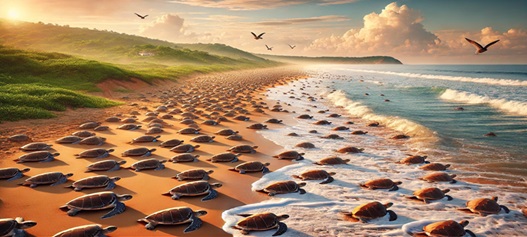Why in the NEWS?
- Olive Ridley sea turtles are famous for their unique breeding behaviour and mass nesting (Arribada).
- In 2025, around 7 lakh Olive Ridley turtles laid eggs at Rushikulya beach in Odisha, which is a new record, and this event is also important because Arribada did not take place at this place in 2024.

Key Points:
- In 2023, around 6.37 lakh Olive Ridley turtles visited Rushikulya beach in Odisha and laid eggs.
- This number reflected a common trend of mass nesting (Arribada) that takes place in the region every year.
- In 2024, there was no mass nesting (Arribada) at this location.
- This was a matter of concern for scientists as this phenomenon is very rare.
- Usually, Olive Ridley turtles return every year on schedule, but in 2024, they did not appear.
- In 2025, around 7 lakh turtles laid eggs at Rushikulya beach between February 16 and 25, which is a new record compared to previous years.
- This event shows that the impact of no nesting in 2024 did not last long, and many favourable factors contributed to their return this year.
What will you read next in this topic?
- Why did such a large number of Olive Ridley turtles return in 2025?
- Why won't the Arribada happen in 2024?
- Arribada - Olive Ridley's unique breeding behaviour
- Olive Ridley Turtles:
Why did such a large number of Olive Ridley turtles return in 2025?
- According to experts, there could be some important reasons behind the return of such a large number of Olive Radley’s this year:
Favourable weather conditions:
- There was no beach erosion due to less rainfall, which provided enough space for laying eggs.
- The wind speed and sea current conditions remained favourable for the turtles.
Physical structure of the beach:
- This year the slope of the beach was relatively low, allowing the turtles to reach the shore easily.
- The quality of the sandy soil was also better, allowing the eggs to remain safe.
Suitable conditions in coastal waters:
- Low wind speed and moderate waves before nesting helped the turtles stay in the coastal waters.
- During mass nesting, the increased wind speed created high waves, allowing the turtles to reach the shore easily.
Natural trends:
- Scientists believe that mass nesting is a biological process, and this phenomenon does not occur naturally in some years.
- It has been observed earlier that sometimes turtles return in large numbers after a gap of one year.
Why won't the Arribada happen in 2024?
- Scientists don't yet know the exact reason, but there could be some possible reasons:
- Natural cycles: Sea turtle nesting does not occur at the same rate every year.
- Climate change: Variations in temperature, ocean currents and other natural phenomena may be responsible.
- Human intervention: Coastal development, fishing activities and pollution may also be important factors.
Arribada - Olive Ridley's unique breeding behaviour
- 'Arribada' is a Spanish word, which means "arrival".
- During this time, thousands of females come to the beach together to lay eggs.
- This behaviour is found only in Olive Ridley and Kemp's Ridley turtles.
- During Arribada:
- More than 600,000 females lay eggs within 5 to 7 days.
- Each female digs a conical nest 1.5 feet deep and lays eggs.
- On an average, a female lays 100-120 eggs.
- The eggs hatch in about 50-60 days, after which the young turtles return to the sea.
Olive Ridley Turtles:
- Olive Ridley turtles are the most commonly found sea turtles. The shell of these turtles is olive in colour, which is why they are called "Olive Ridley".
- A unique feature of these turtles is that they collectively make nests, which is called Arribada.
- Olive Ridley turtles are mainly found in warm waters of the sea.
- They live especially in coastal areas located along the Pacific, Atlantic and Indian Oceans.
- Their main breeding site is Gahirmatha Marine Sanctuary (Odisha), which is considered to be the world's largest sea turtle breeding site.
- Every year millions of female Olive Ridley turtles come to this area of Odisha to lay eggs.
|
Q. What is the process of mass nesting of Olive Ridley turtles called?
(a) Metamorphosis
(b) Arribada
(c) Incubation
(d) Mutation
|



